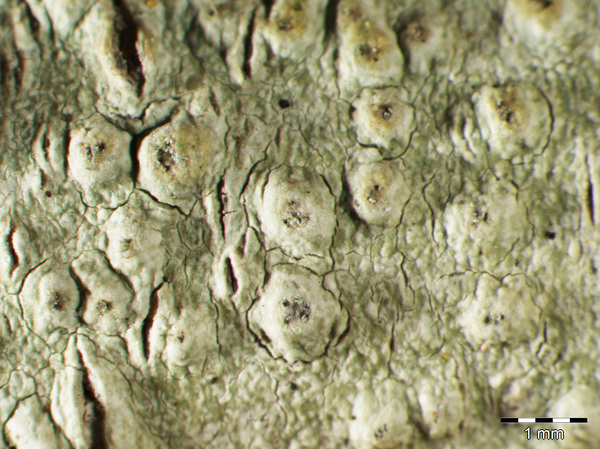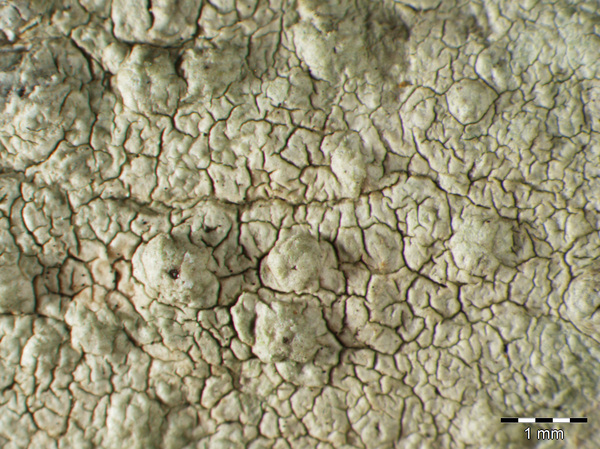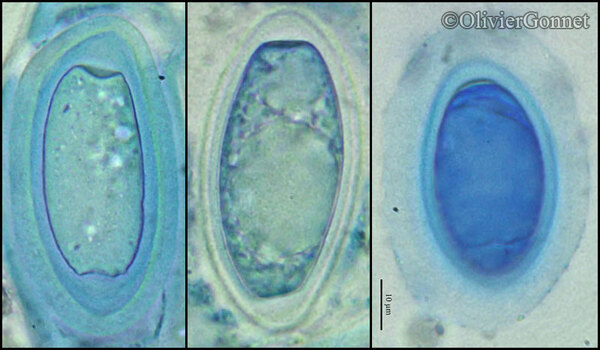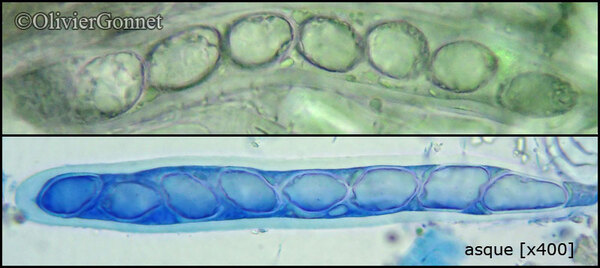Pertusaria werneriana Boqueras
in Boqueras & Llimona, Mycotaxon 88: 489.2003.
Synonyms:
Distribution: S - Camp (Nimis & Tretiach 2004, as P. alpina - TSB 31860), Si (Ravera & al. 2024).
Description: Thallus crustose, episubstratic, rimose-areolate in central parts, continuous in peripheral parts, pale greenish grey or yellow-green. Apothecia perithecioid, immersed in 1-2 mm wide, basally not constricted warts. 1-2 per wart, with a punctiform, pale disc. Epithecium colourless or very pale brown, K-, C-; hymenium colourless; paraphyses branched and anastomosing, poorly coherent; hypothecium colourless. Asci 8-spored (rarely some asci 4-spored), broadly cylindrical, the apex with a broad ocular chamber, the outer sheath K/I+ blue, otherwise K/I-, with an inner extensible layer, Pertusaria-type, wih uniseriately arranged spores. Ascospores 1-celled, hyaline, ellipsoid, 45-60 x 25-30 µm, with a 2-layered, smooth wall. Photobiont chlorococcoid. Spot tests: thallus K+ pale yellow, C-, KC-, P-. Chemistry: 4,5-dichlorolichexanthone, 2'-O-methylperlatolic acid and confluentic acids.Note: a species reported from Spain and Greece, resembling P. alpina but with a different chemistry and distribution, being restricted to warm-humid, mostly coastal sites in the Mediterranean belt; known from a humid gorge near the coast in Campania, perhaps more widespread, but certainly rare.
Growth form: Crustose
Substrata: bark
Photobiont: green algae other than Trentepohlia
Reproductive strategy: mainly sexual
Most common in areas with a humid-warm climate (e.g. most of Tyrrenian Italy)
Commonnes-rarity: (info)
Alpine belt: absent
Subalpine belt: absent
Oromediterranean belt: absent
Montane belt: absent
Submediterranean belt: absent
Padanian area: absent
Humid submediterranean belt: absent
Humid mediterranean belt: very rare
Dry mediterranean belt: absent
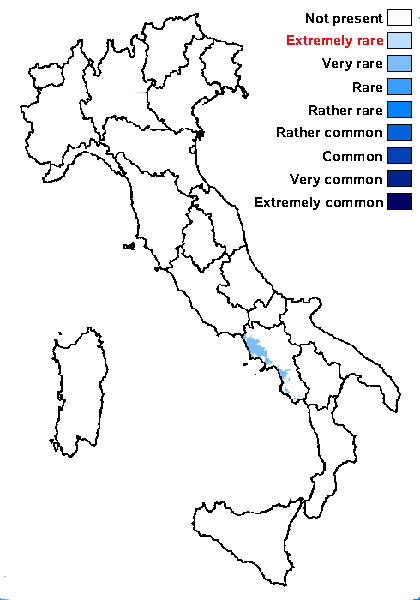
Predictive model
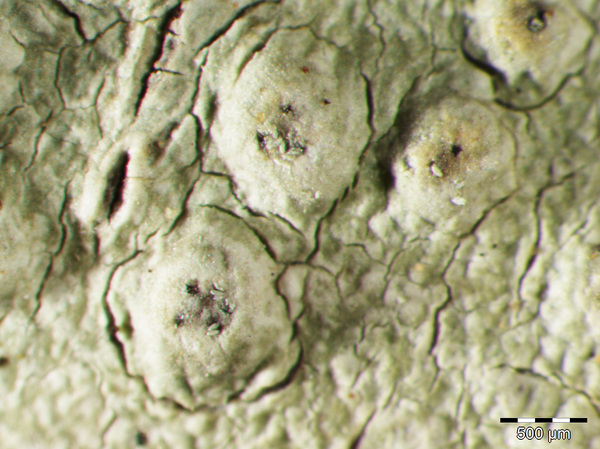
Harrie Sipman – Source http://www.bgbm.fu-berlin.de/sipman/Zschackia/AegeanLichens/CaloplacaAC.htm - As Caloplaca oasis

Courtesy Danièle et Olivier Gonnet - Source: https://www.afl-lichenologie.fr/Photos_AFL/Photos_AFL_P/Text_P_4/Pertusaria_werneriana.htm
France, 21/3/2016 - Forêt Domaniale Mare e Sole - Corse
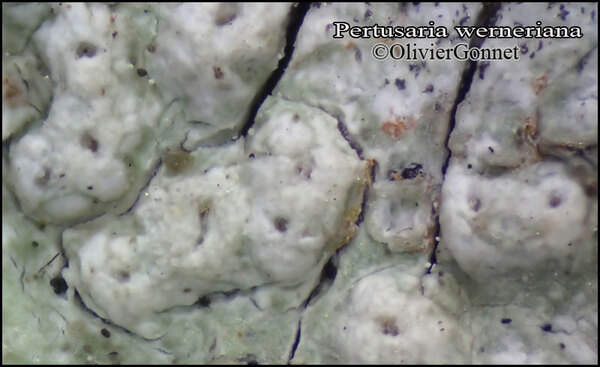
Courtesy Danièle et Olivier Gonnet - Source: https://www.afl-lichenologie.fr/Photos_AFL/Photos_AFL_P/Text_P_4/Pertusaria_werneriana.htm
France, 21/3/2016 - Forêt Domaniale Mare e Sole - Corse
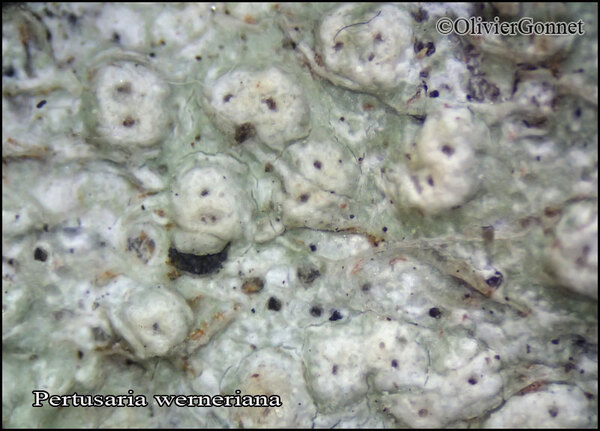
Courtesy Danièle et Olivier Gonnet - Source: https://www.afl-lichenologie.fr/Photos_AFL/Photos_AFL_P/Text_P_4/Pertusaria_werneriana.htm
France, 21/3/2016 - Forêt Domaniale Mare e Sole - Corse

Courtesy Danièle et Olivier Gonnet - Source: https://www.afl-lichenologie.fr/Photos_AFL/Photos_AFL_P/Text_P_4/Pertusaria_werneriana.htm
France, 21/3/2016 - Forêt Domaniale Mare e Sole - Corse
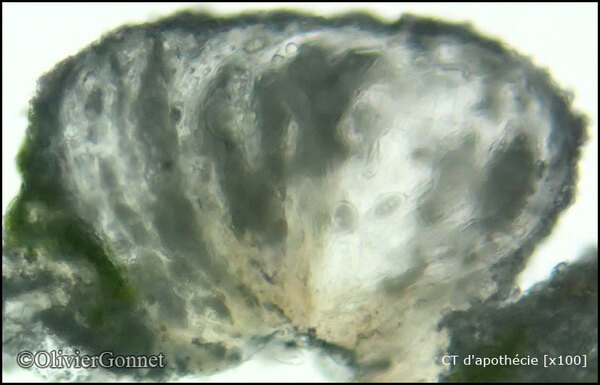
Courtesy Danièle et Olivier Gonnet - Source: https://www.afl-lichenologie.fr/Photos_AFL/Photos_AFL_P/Text_P_4/Pertusaria_werneriana.htm
France, 21/3/2016 - Forêt Domaniale Mare e Sole - Corse
Growth form: Crustose
Substrata: bark
Photobiont: green algae other than Trentepohlia
Reproductive strategy: mainly sexual
Most common in areas with a humid-warm climate (e.g. most of Tyrrenian Italy)
Commonnes-rarity: (info)
Alpine belt: absent
Subalpine belt: absent
Oromediterranean belt: absent
Montane belt: absent
Submediterranean belt: absent
Padanian area: absent
Humid submediterranean belt: absent
Humid mediterranean belt: very rare
Dry mediterranean belt: absent

Predictive model

Harrie Sipman – Source http://www.bgbm.fu-berlin.de/sipman/Zschackia/AegeanLichens/CaloplacaAC.htm - As Caloplaca oasis

Courtesy Danièle et Olivier Gonnet - Source: https://www.afl-lichenologie.fr/Photos_AFL/Photos_AFL_P/Text_P_4/Pertusaria_werneriana.htm
France, 21/3/2016 - Forêt Domaniale Mare e Sole - Corse

Courtesy Danièle et Olivier Gonnet - Source: https://www.afl-lichenologie.fr/Photos_AFL/Photos_AFL_P/Text_P_4/Pertusaria_werneriana.htm
France, 21/3/2016 - Forêt Domaniale Mare e Sole - Corse

Courtesy Danièle et Olivier Gonnet - Source: https://www.afl-lichenologie.fr/Photos_AFL/Photos_AFL_P/Text_P_4/Pertusaria_werneriana.htm
France, 21/3/2016 - Forêt Domaniale Mare e Sole - Corse

Courtesy Danièle et Olivier Gonnet - Source: https://www.afl-lichenologie.fr/Photos_AFL/Photos_AFL_P/Text_P_4/Pertusaria_werneriana.htm
France, 21/3/2016 - Forêt Domaniale Mare e Sole - Corse

 INDEX FUNGORUM
INDEX FUNGORUM
 GBIF
GBIF
